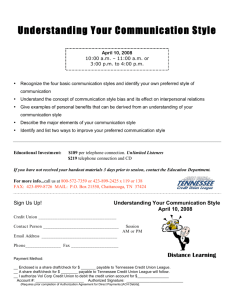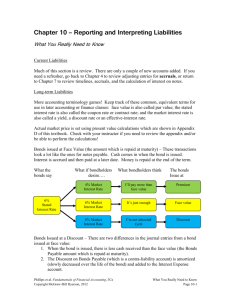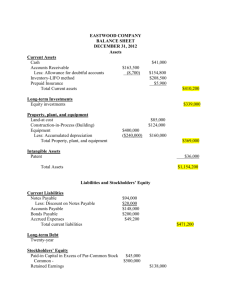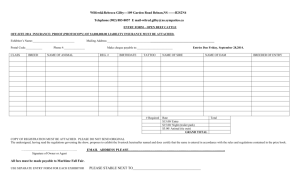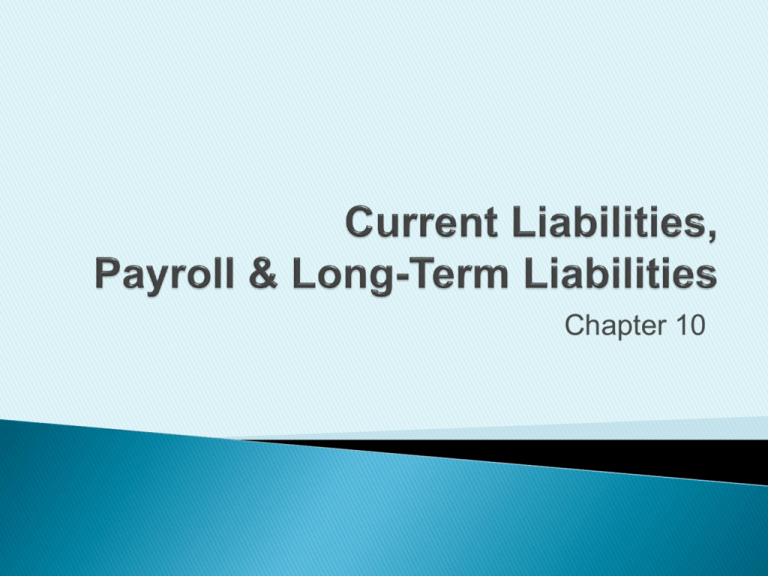
Chapter 10
Account for current liabilities of known amount
Accounts Payable
Amounts owed for products
and services purchased on
account
Short-Term Notes Payable
Common form of financing;
company incurs interest
expense
Sales Tax Payable
Tax levied by state on retail
sales; company collects from
customer and remits to
government
Copyright (c) 2009 Prentice Hall. All rights reserved.
3
Current portion of Long-Term Notes Payable
Principal portion of long-term debt due
in the next year
Accrued Expenses
Expense incurred, but not yet paid; often an
adjusting entry.
Examples: salaries & interest payable
Unearned revenues
Customers make payment before receiving
product or service
Copyright (c) 2009 Prentice Hall. All rights reserved.
4
GENERAL JOURNAL
DATE
DESCRIPTION
DEBIT
CREDIT
2011
3
1
Equipment
16,000
Notes payable
16,000
Purchase equipment by signing a note payable
12
31 Interest expense
1,200
Interest payable
1,200
Accrued interest on note payable
$16,000 x 9% x 10/12
Copyright (c) 2009 Prentice Hall. All rights reserved.
5
GENERAL JOURNAL
DATE
DESCRIPTION
DEBIT
CREDIT
2012
3
1
Interest payable
1,200
Interest expense
240
Notes payable
16,000
Cash
17,440
To record payment of note and interest
$16,000 x 9% x 2/12
Copyright (c) 2009 Prentice Hall. All rights reserved.
6
Account for current liabilities that must be
estimated
Companies guarantee products through
warranty agreements
Warranty expense is estimated in same period
as sale of product
◦ Matching principle
JOURNAL
Date
Accounts
Debit
Warranty Expense
$$$$
Estimated Warranty Payable
Credit
$$$$
8
Copyright (c) 2009 Prentice Hall. All rights reserved.
Potential liability
Depends on a future event
Accounting treatment depends on likelihood that
the future event will create a liability:
Remote
Reasonably
possible
Probable
Copyright (c) 2009 Prentice Hall. All rights reserved.
9
Likelihood of Loss
How to Report
Remote
No disclosure required
Reasonably possible Describe in notes to the
financial statements
Probable
Record an expense and
liability based on
estimated amounts
Copyright (c) 2009 Prentice Hall. All rights reserved.
10
Calculate payroll and payroll tax amounts
Salary
Pay stated at annual, monthly,
or weekly rate
Wages
Pay stated at an hourly rate
Commission Pay stated as percentage of
sales amount
Bonus
Pay over and above base
salary
Benefits
Extra compensation not paid in
cash, such as health insurance
or retirement contributions
Copyright (c) 2009 Prentice Hall. All rights reserved.
12
Straight time
◦ base rate paid for a set number of hours
Overtime
◦ additional time worked for which employees receive a
higher rate
◦ usually 1.5 times the straight time rate
Copyright (c) 2009 Prentice Hall. All rights reserved.
13
Gross pay
• Total amount earned during a
pay period
• Expense to the employer
Net pay
• Take-home pay
• The amount the employee
keeps
Copyright (c) 2009 Prentice Hall. All rights reserved.
14
Gross pay
Income &
Social
security
taxes
Required
deductions
Insurance,
retirement plans,
charitable
contributions
Optional
deductions
Net pay
Copyright (c) 2009 Prentice Hall. All rights reserved.
15
Government requires employers to deduct income
tax from employees’ gross pay
Amount depends on:
◦ Gross pay
◦ The number of withholding allowances employee claims
on Form W-4
Each allowance lowers amount of tax withheld
Number of allowances depends on marital status and
number of children and/or dependents
Copyright (c) 2009 Prentice Hall. All rights reserved.
16
Two components:
◦ Old age, survivors’ and disability insurance (OASDI)
6.2% of pay up to a wage base which increases each
In 2008, wage base = $102,000
◦ Health insurance (Medicare)
1.45% of pay with no maximum wage base
Copyright (c) 2009 Prentice Hall. All rights reserved.
17
In addition to employee withholdings, employers
pay at least three taxes based on payroll:
◦ Social Security (FICA) tax
Employer matches amount withheld from employees’ pay
◦ State unemployment compensation tax (SUTA)
In many states, 5.4% of first $7,000 paid to each employee
◦ Federal unemployment compensation tax
Frequently, 0.8% of the first $7,000 paid to each employee
Copyright (c) 2009 Prentice Hall. All rights reserved.
18
Journalize basic payroll transactions
Salaries
expense
Employee
benefits
Employer
Payroll
Taxes
Copyright (c) 2009 Prentice Hall. All rights reserved.
20
GENERAL JOURNAL
DATE
DESCRIPTION
DEBIT
CREDIT
Salary expense
Employee income tax payable
FICA tax payable
Payable to health insurance
Payable to United Way
Salary payable
Copyright (c) 2009 Prentice Hall. All rights reserved.
21
GENERAL JOURNAL
DATE
DESCRIPTION
DEBIT
CREDIT
Health insurance expense
Life insurance expense
Retirement plan expense
Employee benefits payable
Copyright (c) 2009 Prentice Hall. All rights reserved.
22
GENERAL JOURNAL
DATE
DESCRIPTION
DEBIT
CREDIT
Payroll tax expense
FICA tax payable
Federal unemployment tax payable
State unemployment tax payable
Copyright (c) 2009 Prentice Hall. All rights reserved.
23
Hours Pay
Total
rate
40
$14
$560
22
$21
62
462
$1,022
GENERAL JOURNAL
DATE
DESCRIPTION
DEBIT
Salary expense
CREDIT
1,022
Employee income tax payable
73
FICA tax payable
78
Payable to United Fund
10
Salary payable
861
Copyright (c) 2009 Prentice Hall. All rights reserved.
24
Controls to Safeguard
Payroll Disbursements
Controls for efficiency
Use of two payroll
bank accounts
Use of computer
processing
Hiring and firing
separate from
accounting
Use of photo IDs &
time clocks
Copyright (c) 2009 Prentice Hall. All rights reserved.
25
Human
Resources
• Hire & fire
Accounting
• Records payroll
transactions
Payroll
• Keep employee
earnings records
Treasurer
• Distributes
paychecks
Copyright (c) 2009 Prentice Hall. All rights reserved.
26
Describe bonds payable
Large company issue bonds to public to raise
money
◦ Multiple lenders = bondholders
Each bondholder receives bond certificate that shows
Amount borrowed (principal)
Maturity date
Interest rate
Company pays interest (usually semi-annually) to
bondholders
◦ Bondholders receive interest
Copyright (c) 2009 Prentice Hall. All rights reserved.
28
Principal or Maturity value
• Amount borrower must pay back on maturity date
Maturity date
• Date on which borrower must pay principal to the
bondholders
Stated interest rate
• Annual rate of interest borrower pays to
bondholders
Copyright (c) 2009 Prentice Hall. All rights reserved.
29
Term bonds
◦ All mature at same date
Serial bonds
◦ Mature in installments at regular intervals
Secured bonds
◦ Bondholder has right to assets if company fails to pay
principal or interest
Debenture
◦ Unsecured; not backed by company’s assets
Copyright (c) 2009 Prentice Hall. All rights reserved.
30
Maturity(par) value
Discount
• $1,000 bond issued for
$1,000
• No discount or
premium
• $1,000 bond issued for
$980
• Issued below maturity
value
Premium
• $1,000 bond issued for
$1,015
• Issued above maturity
value
Copyright (c) 2009 Prentice Hall. All rights reserved.
31
Quoted as a percent of maturity value
A $1,000 bond quoted a price of
101.5 would sell for $1,015
A $1,000 bond quoted a price of
89.75 would sell for $897.50
Issue price determines cash company receives
Company must pay maturity value at maturity date
Copyright (c) 2009 Prentice Hall. All rights reserved.
32
Money earns income over time
Investors will pay less than $1,000 now to receive
$1,000 in the future
2009
Present value:
Today’s price
$750
2012
Present value is always
less than future value
Future value:
Maturity value
$1,000
Copyright (c) 2009 Prentice Hall. All rights reserved.
33
Stated interest rate
Determines amount of
cash interest borrower
pays each year
Remains constant
Stated
interest
rate
Market interest rate
Rate investors demand
for loaning money
Varies daily
Market
interest
rate
Issue price of bonds payable
9%
=
9%
Maturity value
9%
<
10%
Discount (below maturity value)
9%
>
8%
Premium (above maturity value)
Copyright (c) 2009 Prentice Hall. All rights reserved.
34
Measure interest expense on bonds using the
straight-line amortization method
GENERAL JOURNAL
DATE
Issue
date
DESCRIPTION
DEBIT
Cash
CREDIT
100,000
Bonds payable
100,000
To record issuance of 8% bonds at maturity value
Int.
pmt
dates
Interest expense
$100,000 x 8% x 1/2
4,000
Cash
4,000
To record semi-annual interest payment
Copyright (c) 2009 Prentice Hall. All rights reserved.
36
GENERAL JOURNAL
DATE
DESCRIPTION
DEBIT
Maturity Bond payable
date
Cash
CREDIT
100,000
100,000
To record payment of bonds at maturity
Copyright (c) 2009 Prentice Hall. All rights reserved.
37
GENERAL JOURNAL
DATE
DESCRIPTION
DEBIT
Issue Cash
date Discount on bonds payable
CREDIT
98,000
2,000
Bonds payable
100,000
To record issuance of $100,000, 10-year, 8% bonds at 98
Contra account to
Bonds payable
Copyright (c) 2009 Prentice Hall. All rights reserved.
38
Long-term liabilities
Bonds payable
$100,000
Less: Discount on bonds payable
( $2,000) $98,000
Carrying
value
Copyright (c) 2009 Prentice Hall. All rights reserved.
39
$2000/10
x 6/12
GENERAL JOURNAL
DATE
DESCRIPTION
DEBIT
Int. pmt Interest expense
date
Discount on bonds payable
CREDIT
4,100
100
Cash
4,000
$100,000 x 8% x 6/12
Copyright (c) 2009 Prentice Hall. All rights reserved.
40
GENERAL JOURNAL
DATE
DESCRIPTION
DEBIT
Issue Cash
date
Premium on bonds payable
CREDIT
104,000
Bonds payable
4,000
100,000
To record issuance of $100,000, 10-year, 8% bonds at 98
Companion account
to Bonds payable
Copyright (c) 2009 Prentice Hall. All rights reserved.
41
Long-term liabilities
Bonds payable
$100,000
Plus: Premium on bonds payable
$4,000 $104,000
Carrying
value
Copyright (c) 2009 Prentice Hall. All rights reserved.
42
GENERAL JOURNAL
DATE
DESCRIPTION
Int. pmt Interest expense
date Premium on bonds payable
$4,000/10
x 6/12
DEBIT
CREDIT
3,800
200
Cash
4,000
$100,000 x 8% x 6/12
Copyright (c) 2009 Prentice Hall. All rights reserved.
43
Bonds payable
$100,000
Premium
$200
$4,000
$3,800
Carrying value after first
interest payment =
$103,800
Copyright (c) 2009 Prentice Hall. All rights reserved.
44
Interest payments seldom occur at year-end
◦ Interest must be accrued
GENERAL JOURNAL
DATE
12
DESCRIPTION
$2,000/10 x 3/12
DEBIT
31 Interest expense
CREDIT
2,050
Discount on bonds payable
Interest payable
50
2000
(100,000 x 8% x 3/12)
Copyright (c) 2009 Prentice Hall. All rights reserved.
45
The following interest payment entry will take into
account the adjusting entry previously made
GENERAL JOURNAL
DATE
3
DESCRIPTION
x 3/12
DEBIT $2,000/10
CREDIT
31 Interest payable
2,000
Interest expense
2,050
Discount on bonds payable
50
Cash
4,000
(100,000 x 8% x 1/12)
Copyright (c) 2009 Prentice Hall. All rights reserved.
46
$100,000 x 8% x 6/12 =
$4,000
Accrued
interest
Cash interest
payment
$2,000
$2,000
(100,000 x 8% x 3/12)
(100,000 x 8% x 3/12)
January 1:
bond date
April 1:
issue date
Interest
expense
June 20:
1st interest
payment
Copyright (c) 2009 Prentice Hall. All rights reserved.
47
GENERAL JOURNAL
DATE
4
1
DESCRIPTION
Cash
DEBIT
102,000
Bonds payable
100,000
Interest payable
6
30
CREDIT
2,000
Interest expense
2,000
Interest payable
2,000
Cash
4,000
Copyright (c) 2009 Prentice Hall. All rights reserved.
48
Report liabilities on the balance sheet
Any Company
Classified Balance Sheet (partial)
December 30, 2010
Liabilities
Current liabilities:
Accounts payable
7,200
Salaries payable
1,500
Unearned revenue
400
FICA tax payable
100
Employee income tax payable
150
Interest payable
2,100
Current portion of long-term debt
5,000
Total current liabilities
Long-term liabilities:
Note payable
Bonds payable, net of discount
16,450
50,000
98,200
Total long-term liabilities
148,200
Total liabilities
164,650
Copyright (c) 2009 Prentice Hall. All rights reserved.
50
Compare issuing bonds to issuing stock
Issuing bonds
Must pay interest and
principal to bondholders
Reduces net income
Issuing stock
◦ Interest expense
Can increase earnings
per share
Does not have to be “paid
off”
Does not affect net
income
Increases number of
shares outstanding
◦ Leverage
Copyright (c) 2009 Prentice Hall. All rights reserved.
52



